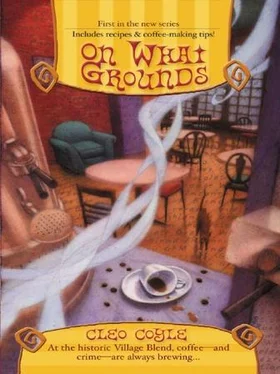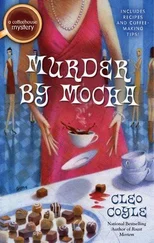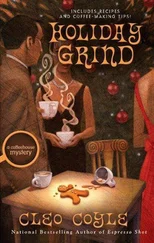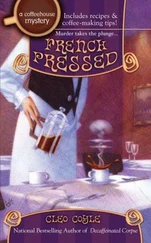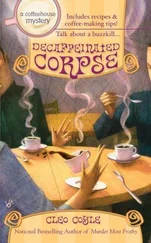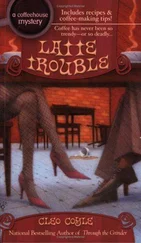My mind raced. Tea drinkers were not common at the Blend. But just today I’d spoken to four—Letitia Vale, who had no motive; Anabelle’s stepmother, Darla Branch Hart, who either had a motive or was simply an opportunist in the face of her stepdaughter’s tragedy; and the two Russian dancers, Vita and Petra, who certainly did have a motive.
“What’s up?” Matt asked. “What are you thinking?”
“That maybe I should have learned to read tea leaves instead of coffee grounds.”
The next morning, I opened the Blend on time. At ten minutes after six, Dr. John Foo was through the door like clockwork.
“Good morning, Clare,” he said.
“The usual, Dr. Foo?”
“Yes, thank you.”
As I pulled the two espresso shots for the double tall latte, I made the usual small talk with the handsome young Chinese-American medical resident. After his morning workouts at the dojo down the street, he was usually in a chatty mood. For the past four weeks, since I began managing the Blend again, I listened and learned.
The first time we met, he’d told me one of the forms he studied was Wing Chun Gung Fu. “It was actually invented by a Buddhist nun named Ng Mui,” he’d said.
I knew nothing about martial arts, or Buddhism. But any form of self-defense invented by a nun was definitely worth learning more about in my book, so I’d been chatting about it with him ever since. Dr. Foo had even showed me a few simple moves, encouraging me to take it up at his dojo—but finding free time had been a challenge over the last four weeks. The struggle to get the Blend back on its feet had been all-consuming.
“So how are things at the hospital?” I finally got around to asking as I gave him his latte.
“They’re going well,” he said. “I’m learning a lot on this rotation in the intensive care unit.”
He took his first sip, closed his eyes and smiled. “Great cup, Clare. As usual. Thanks.”
“You’re very welcome.”
As he picked up the protective cardboard sleeve and slipped it onto the very hot cup, I asked, “Have you learned anything more about Anabelle Hart?”
“Oh, yes,” he said. “I got the information you wanted. But this has to stay confidential, agreed?”
“Agreed.”
What Dr. Foo said about Anabelle’s condition shocked me, but it didn’t change my plans. So, a few hours later, at just after 10 A.M., Matt took over managing the Blend and I ventured out.
The Dance 10 Studio was located in a refurbished office furniture warehouse on Seventh Avenue South, a bustling thoroughfare that cut through the heart of Greenwich Village’s historic district.
Lined with bars, restaurants, off-Broadway theaters, and cabarets, the wide, high-traffic avenue attracted high-spirited crowds nightly. On some Friday and Saturday evenings, it reminded me of Mardis Gras in the French Quarter. Anything went.
On a Friday morning, however, the wide avenue was quiet. The windows of the bars, restaurants, and cabarets were dark, and the vehicular traffic relatively light as I crossed the street.
I actually wanted to approach Dance 10 from the opposite side of the avenue from where it stood. According to Tucker, there was a little bar located there, and randy college boys, cheap beers in hand, were said to use the vantage to drool up at the dance studio’s wall of windows, where honed female forms floated across the wood floor during the last rehearsals of the night.
“The straight little boys start their pub crawls there,” Tucker explained to me, “because if they don’t manage to get lucky during the course of the night, then at least they’ve got a female form or two to fantasize about in the wee hours.”
I decided to see for myself if there was any truth to that particular rumor—and, unfortunately, there was.
Directly across the avenue from Dance 10 were the tall front windows of Mañana, a little dive of a bar with a fake south-of-the-border motif—the prerequisite sombreros, horse blankets, and piñatas dangled from hooks on its walls and over its stained wooden bar.
Mañana survived for four reasons, according to Tucker:
It caught the overflow from the much bigger Caliente Cab Co., a huge bar/restaurant with its most memorable characteristic being a giant-size margarita glass hoisted over its doorway.It served the cheapest beers in the area. (The stuff tasted like “piss,” so said Tucker, but it got you drunk for far less money.)The name Mañana meant “tomorrow” and was sometimes used among college freshmen who enjoyed showing off their knowledge of high school Spanish. Consequently, “See you Mañana” would confuse their half-drunk friends who hadn’t studied the language and they’d end up stumbling into this eponymous dive. And last but not least—The view.
Standing outside the little bar, I pretended to be a twenty-one-year-old college junior with a frosty mug of urine bought during half-price happy hour. Looking up, I could see a clear-as-crystal view of Dance 10’s large third-floor practice room. In the early evening with the lights blazing inside, I figured those young men probably fogged up Mañana’s front windows pretty good.
This opened up yet another possibility for a motive and a suspect. If college boys were using this vantage to drool from a distance at the beautiful girls in the window of Dance 10, then what were the odds one of them might have become obsessed with Anabelle from afar?
Perhaps one of them had tried to make a pass and failed, and somehow Anabelle ended up falling down the stairs when she tried to get away.
That theory would hold water if the front or back door to the Blend had been left unbolted, but it hadn’t.
No sign of a window escape, either.
Someone had obtained a key—or made a copy. I sincerely doubted that any of Anabelle’s coworkers had any real motive to hurt or kill her. Which sent me right back to Dance 10, where Anabelle rehearsed for hours and a jealous codancer might have slipped the girl’s key ring away to make copies.
I climbed the stairs to the studio, bribe in hand—a cardboard tray snugly filled with four double tall lattes (who doesn’t like lattes?).
According to the schedule posted in the lobby, Jazz Dance had just finished. Anabelle had attended this class religiously. Typically, she would open the coffeehouse at 5:30 A.M., leave at 9:30 to make the 10 A.M. jazz class, and continue taking dance classes for another four to five hours. Then she’d come back to the Blend to put in another three to five hours.
That’s why I’d promoted her to assistant manager. The girl was working the equivalent of a full-time schedule for the Blend, and in the short time I’d known her, she’d been a reliable opener.
“Can I help you?”
A woman in her late twenties with an abundance of good posture spoke to me with the sort of sharp-edged tone that really means, “Who the hell are you? And what do you want?”
She wore a large burgundy sweater over black tights, and her light brown hair had been pulled back into a tight bun. She sat alone at a small wooden desk inside a tiny office covered with schedules, announcements, and show posters. The back wall was lined with old file cabinets and a tall column of stacked chairs.
This must be the second floor “reception and registration office,” I decided. According to the building directory in the lobby, this floor also held practice rooms A, B, and C. I could hear piano music filtering out of one closed door, a hip-hop beat out of another.
“I’m looking for the teacher of the ten A.M. Jazz Dance class,” I told the young woman.
“You can leave your delivery here,” said the young woman. “What do we owe you?”
Читать дальше
